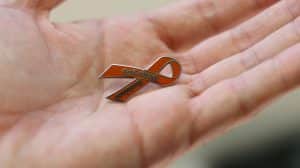About the Ochre Ribbon Campaign

Aboriginal people across Australia continue to experience the detrimental impacts of family and domestic violence within our communities.
The Ochre Ribbon Campaign symbolises the collective voice of our people to stop violence and commit to fostering safer communities for
our elders, men, women, and children.
The colour and loop of the Ochre Ribbon represent the powerful connection to our lands and our lives. This connection intersects with the understanding that we all require the support of each other.
From this, we reflect on the resilience and strength of our people and the survivors of abuse, who hold many of the solutions needed to pave our own pathways to better standards of social, economic, and physical safety and well-being.
The Ochre Ribbon Campaign reminds all of us to take proactive steps towards contributing to making our communities safer, happier, and healthier places for our people to thrive.
The History of Ochre Ribbon
The Ochre Ribbon Campaign was born from a tragedy in 2014 when a proud Aboriginal woman, lost her life to domestic violence in Meekatharra, Western Australia. Her family, still grappling with the devastating impact of her death, approached the local Aboriginal Family Legal Services (AFLS) Kalgoorlie office for help in honouring her memory. Together, they created white ribbons for attendees to wear at her funeral—a simple yet powerful symbol of opposition to violence against women.
This moment of mourning sparked a movement. The AFLS team and the family recognised the urgent need for a campaign specifically addressing violence within Aboriginal communities, focusing on culturally centred values and solutions. In 2015, the Ochre Ribbon Campaign was officially launched by AFLS in Perth, with its inaugural event held on March 18, 2015.
The ochre colour of the ribbon holds deep cultural significance. It represents the earth and the connection of Aboriginal people to their land, as well as the strength and resilience of Aboriginal communities. The looped design symbolises the support and unity needed to overcome the challenges of family and domestic violence.
Since its launch, the Ochre Ribbon Campaign has become a national initiative, endorsed by organisations such as the National Family Violence Legal Prevention Services Forum. Events are held annually and year-round across Australia, engaging communities in meaningful dialogue, raising awareness, and fostering collective action.
Why February 12th Was Chosen
February 12th holds a deeply significant place in the Ochre Ribbon Campaign. This date was chosen to commemorate the tragic loss of a young Aboriginal girl who took her own life on February 12, 1999. Her death led to a Parliamentary inquiry, coronial findings, and the eventual closure of the Swan Valley Nyoonga Community. It also catalysed the Sue Gordon Inquiry, which investigated government agencies’ responses to complaints of family violence and child abuse in Aboriginal communities.
This date not only honours her memory but also serves as a stark reminder of the need for systemic change and community action to address violence, neglect, and abuse in Aboriginal communities.
The campaign also commemorates Ochre Ribbon Week commencing on February 12, a time to reflect on the impact of violence and to honour survivors while calling for lasting change. Through this date, the campaign reminds us all of the ongoing responsibility to protect and uplift our communities, fostering a future free from violence.
AFLS acknowledges the wishes of the families of the ladies to whom the Ochre Ribbon Campaign was created and have removed the ladies names.
Vision
A future where Aboriginal communities are strong, safe, and free from the devastating impacts of family and domestic violence. We envision a world where our elders, men, women, and children live with dignity, resilience, and connection to their culture and land, thriving in safe and supportive environments.
Mission
To amplify the voices of Aboriginal people and communities through the Ochre Ribbon Campaign, raising awareness about family and domestic violence, and fostering a collective commitment to creating safer, healthier, and more united communities. By promoting cultural values, supporting survivors, and empowering our people to lead the change, we strive to build pathways to lasting social, economic, and physical well-being.
Vision for the Future
The Ochre Ribbon Campaign envisions a future where Aboriginal communities thrive in safety, dignity, and well-being, free from the devastating impacts of family and domestic violence.
As Corina Martin, CEO of AFLS, has said:
“Family-based violence must be seen as a human rights issue to gain the focus it deserves in our institutions, governments, and communities. Under the symbol of the Ochre Ribbon, we can educate, collaborate, and build a safer community.”
The campaign’s vision is to:
- Empower survivors: Create safe spaces for women and children to heal and grow.
- Foster unity: Strengthen partnerships between organisations, communities, and individuals to work collectively toward solutions.
- Raise awareness: Promote a deeper understanding of what constitutes violence and abuse, including often-overlooked elements.
- Drive systemic change: Advocate for stronger institutional and governmental support to prevent and address family violence.
- Celebrate resilience: Honour the strength and contributions of survivors who are paving the way for change.
As the campaign moves forward, AFLS aims to deepen its impact through education, advocacy, and community-led initiatives. The Ochre Ribbon Campaign calls on all Australians to “Don’t Silence the Violence” and take proactive steps toward a future where Aboriginal people can thrive in safe and supportive environments.
Together, we stand united under the Ochre Ribbon—a symbol of resilience, strength and hope for a better tomorrow.




